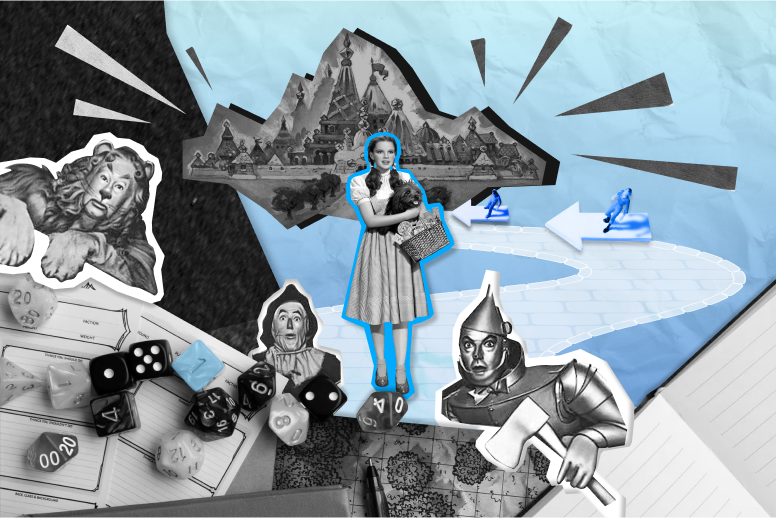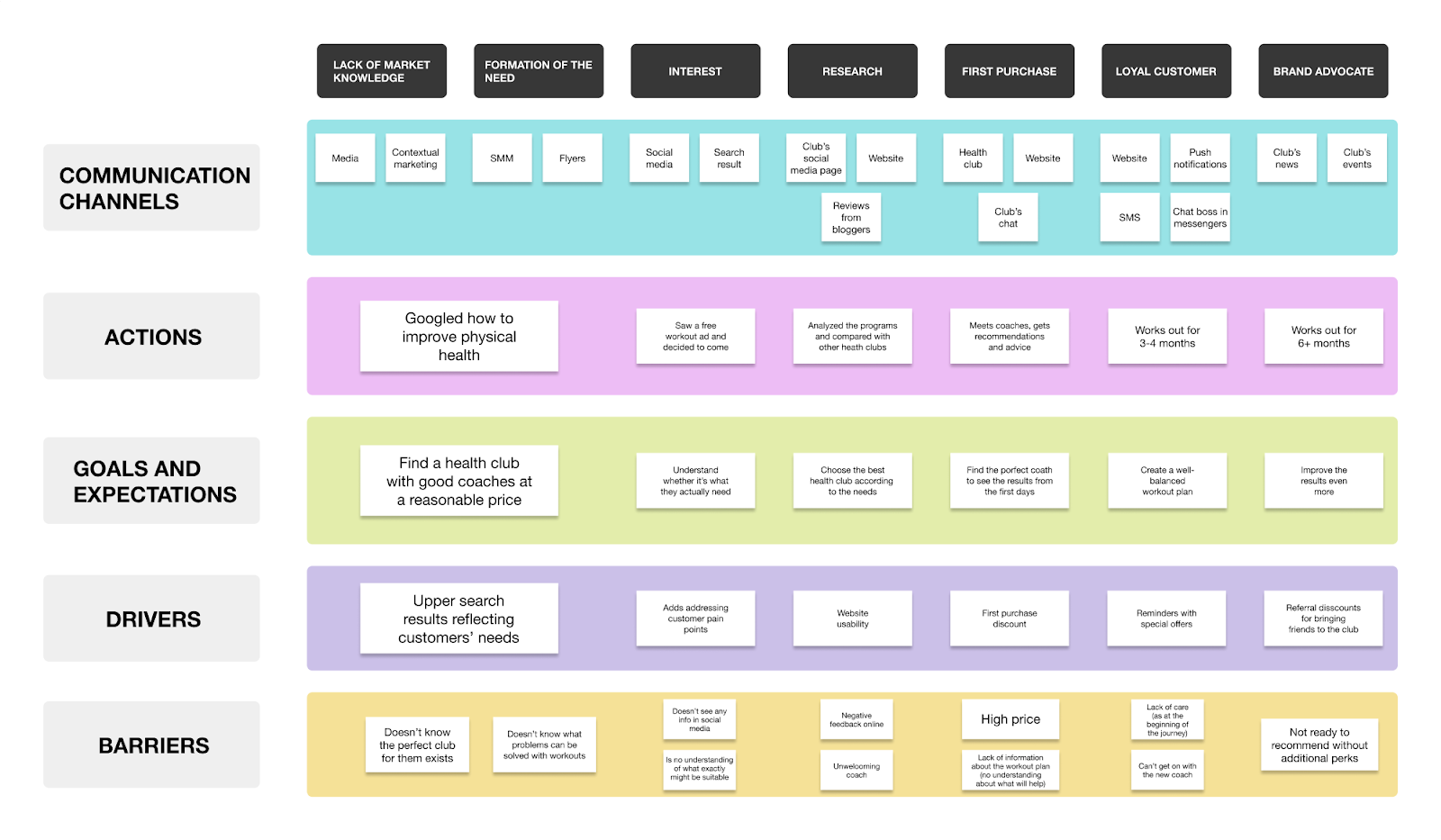Developing a Customer Journey Map with Unspecified Needs

Marketers create customer journey maps (CJMs) to understand how consumers behave from the moment they first realize the need for a product to the point of purchase. But what if the product can solve problems that potential customers haven't even thought about yet?
Why customer needs are essential for creating a CJM
Chances are, everyone has encountered a situation where a company offered exactly what they were thinking: "This is just what I need!" even if they didn't realize it before. Those distant from marketing may dismiss it as mere coincidence. Experienced marketers, however, recognize it as a powerful sales funnel: identifying customer pain points at the right time and place based on their goals, motivations, emotions, and past experiences.
A customer journey map (CJM) helps marketers identify the problems customers face and develop corresponding offers and solutions.
Here's an example of a CJM for a fitness club client without an explicit need at the beginning of the customer journey:

The most important thing here is for the customer journey map to always remain customer-centric. It's necessary to gather essential data about customers to understand their needs, preferences, disappointments, and reasons for problems.
To ensure that you truly need all the information you receive, pay attention to how you formulate questions. For example, if you provide email marketing services, you can ask questions like:
- "How did you realize you needed email campaigns?"
- "What goals did you want to achieve with them?"
- "Were you able to achieve these goals?"
- "What difficulties hindered you in solving the problems?"
What to do if customer needs are undefined
If you're unsure about what customers want, analyze other data and focus on overcoming small challenges they may potentially encounter on the path to purchase and, consequently, on the path to becoming loyal brand customers.
Let's consider which parts of the CJM need special attention when working with such customers and how to organize this process.
Creating customer personas
A customer persona is how you envision the ideal customer: their characteristics, preferences, and so on. The number of such personas depends on the brand's specifics. To understand who your ideal buyer is, use qualitative and quantitative research, surveys, and other audience analysis methods.
Start by dividing your audience into primary segments and formulate hypotheses about the characteristic features of your customers. Then, confirm these hypotheses by thoroughly surveying representatives of various segments. This way, you'll have up-to-date information about customers' goals and motivations, understanding what your customers think and feel at each stage of the journey.
Save this information in the customer persona profile and attach a photo (you can generate them based on typical customer characteristics using artificial intelligence). It's best if you create separate customer journey maps for each persona.
For example, it might look like this:

This approach requires a lot of effort, but it will be much more effective than just creating customer journey maps based on your assumptions.
Describe communication channels
When you know who your customers are, you can easily select the appropriate communication channels to start sending them information about products or services right from the start through the right channel. For example, Generation Z representatives respond better to product promotion on social media and listen to the opinions of bloggers and celebrities they follow. Conversely, older generations gather information about products and services from all over the internet: they watch reviews, read customer feedback, etc. Once you've chosen the primary communication channels, consider how you'll convey information to the user: through videos, email newsletters, contextual marketing, blog articles, and more.
Here's an example of communication channels for CJM:

Describe the stages of the customer journey
The number of stages may vary, but typically six steps are identified in the customer journey towards becoming a brand advocate:
- Need;
- Interest;
- Research;
- First purchase;
- Loyal customer;
- Brand advocate.
Record the goals and expectations of customers at each stage of the journey - this will help address minor challenges at any of the steps.
For example, here are the goals and expectations of a fitness club's customers at different stages of the customer journey:

Identify barriers along the customer journey and find ways to overcome them
Barriers hinder people from making a purchase: high prices, poor customer service, negative reviews, etc. These difficulties may not always be obvious: for example, inconvenient parking or an unpleasant customer service representative. Such details are often extremely difficult to predict, so it's important to learn about them directly from your actual customers.
For each stage of the journey, find several ways for customers to overcome obstacles and become loyal patrons.
In the example below are potential barriers along the fitness club's customer journey:

Create marketing driving forces
Driving forces help people move to the next stage of the customer journey map: discounts, customer reviews, bonuses, and so on. They can vary depending on the customers' goals at each stage: for example, if someone wants to save money, the main driving force will be cost. And if someone wants to join a community, then exclusive club events for members will work in the right direction. To understand what's important to customers, send email surveys, SMS, push notifications, use social media, and other tools to gather customer feedback.
Here are possible driving forces for a fitness club customer:

Conclusion
If a potential customer hasn't yet realized whether they need the product, start creating a customer journey map by identifying the customer persona.
Analyze your audience, determine who your customers are, and which communication channels are best to use to attract them. Use these channels to send information that will help future customers solve their problems.
For each stage of the customer journey map, think about:
- the obstacles customers may encounter;
- ways to overcome these problems;
- possible driving forces that will move customers to the next level of the customer journey map.
When all communication components with potential customers are added to the map, you'll see the weak points in the customer's journey. CJM will show you what you're doing right and what can be improved to help customers realize their needs, make informed decisions, and take action.
Source: Only Influencers
You might be interested in:
For those who are looking for ideas to improve their email strategy.
Read moreHow to evaluate the effectiveness of complex campaigns? Consider the time factor and detail your customers according to it. Cohort analysis will help you with this.
Read moreCreate a website, a chatbot or a mobile app without programming skills. Do you think it's impossible? Well, you need to learn more about low-code and no-code.
Read more